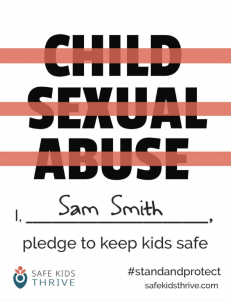Read the Report
Home / Read the Report
Communication
Two important keys to helping organizations change and sustain behaviors are the amount of communication that occurs about the new expectations and the number of people involved in the communication. Open and extensive lines of communication ensure that more people know about a new initiative sooner. In attempting organizational change, leadership must make the case – and provide mechanisms for enabling the change and its assessment. Top leadership must then hold itself, all management, and all employees accountable to “be” the desired change in all their attitudes and actions. An important element for sustaining forward momentum in child abuse prevention initiatives is communication about how the effort is evolving, and feedback from leadership reflecting its ongoing commitment to the process. This feedback should include:
- Regular reminders (newsletters, bulletins, newspaper articles, etc.) of the responsibilities associated with maintaining safe physical and virtual environments, how the YSO is complying with those responsibilities, and the results associated with doing so;
- Periodic statements by the organization’s leadership concerning the ongoing commitment to its child protection policy and to the vigilance necessary to protect children and youth;
- Organization-wide distribution of policies and procedures for child protection, the code of conduct, abuse reporting procedures and lines of communication, results of recent internal safety “audits”, etc.;
- Organizational updates about the status of programs, schedules for training, lists of the categories of people to be trained;
- Checklists about what is necessary to have in place or to have accomplished to be considered in compliance with the YSO’s safe environment policies, and ready for an on-site, off-site, or overnight activity;
- A regular flow of information and data from departments and communication with individuals about their particular experiences with the requirements (perhaps, as stated in the Code of Conduct section, as part of regular supervision and performance reviews);
- Safety awards, certificates or recognition for individual or group efforts to ensure the safety of the children/youth in the organization’s care;
- Internal audits and data collection concerning outcomes that demonstrate whether and how the desired results are being achieved and maintained (more below);
- Periodic evaluation of the overall policies (more below), and;
- Identification of an individual or small team to continue facilitating and monitoring the change process and become a resource to others in the organization.
Frequent communication from YSO leadership to all constituencies (including parents) about its commitment to child abuse prevention and to child/youth safety helps to ensure that supervisors, staff and volunteers are not only aware of the requirements, but also helps to build ongoing awareness, sustain vigilance, and create an environment where unsafe practices are noticed because they are not the norm, and where they can be corrected before a child or youth is harmed. Communication and support from leadership helps to transform policy into practice.
With the elements above in place, organization leaders help to build a culture of safety that maintains a strong and permanent vigilance over the well-being of the children entrusted to their care – not because it is some “requirement” imposed by “people up the chain”, but because it is part and parcel of an ongoing personal and communal behavioral commitment to keep the children safe and protected. Sustaining a new child abuse prevention program depends on empowering all managers, supervisors, employees and volunteers and growing their sense of ownership and responsibility.
A positive organizational culture should require (among other things) adherence to a clear code of conduct, and education for all its members about child sexual abuse. It should facilitate the reporting of abuse by normalizing conversations about child maltreatment, encouraging all members to monitor and to speak up when infractions occur or unsafe situations are observed, helping people to overcome their natural reluctance to report or to “get involved”, and ensuring that all suspicions or allegations involving potential harm to children and youth are taken seriously and that no one is considered exempt from an investigation due to his or her prestige, seniority, or status. In any organization, there is a great difference between leadership that exerts “power over” their subordinates in trying to get something done, and leadership that creates and fosters a culture of “power with” – inviting participants to join together in the change process with the opportunity to help it evolve over time. The requirements for true system and behavioral change require a high level of sustained commitment and a steadfast effort.
- Acknowledgements
- Executive Summary
- Introduction
- How to Read This Report
- Mission & Purpose of Taskforce
- A Brief History of How the Taskforce Was Organized
- The Charge of the Legislative Language
- Key Sections
- Section 1: Developing Policies and Procedures for Child Protection
- Section 2: Screening and Background Checks for Selecting Employees and Volunteers
- Section 3: Code of Conduct and Monitoring
- Section 4: Ensuring Safe Physical Environments and Safe Technology
- Section 5: Recognizing, Responding to, and Reporting Allegations and Suspicions of Child Sexual Abuse
- Section 6: Training About Child Sexual Abuse Prevention
- Additional Considerations
- Applying the Framework: A Five-Year Plan
- Appendices
- Section-Specific Appendices
- Downloadable Resources

Take the Pledge to Keep Kids Safe
Join us and commit to learning how you can protect the children you serve.
Sign Up to Access Your Learning Center
Customized child sexual abuse prevention guidelines to meet the unique needs of any organization that serves children.
- Evidence-informed guidance
- Actionable prevention steps
- Keeps track of your progress
- Tailored learning tracks


